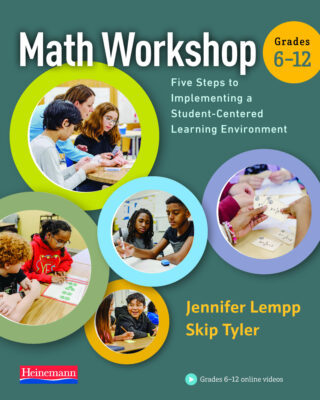
The following is an adapted excerpt from Jennifer Lempp’ and Skip Tyler' forthcoming Math Workshop, Grades 6-12. Preorder available now!
***
Students come into class with a range of background knowledge, interests, strengths, socioeconomic circumstances, and languages—it’s no wonder addressing the needs of all learners can often feel overwhelming. Differentiation is defined by Tomlinson and Imbeau (2010) as classroom practice that has a balanced emphasis on individual students and course content. In math workshop, differentiation is purposeful and plentiful, and it happens for everyone, not just for students who are considered mathematically gifted or for students with special needs. Differentiation is not just a buzzword—it is at the center of the entire philosophy of math workshop.
Elements of Differentiation
The modifications of four curriculum-related elements are at the core of differentiation—content, process, product, and affect (Tomlinson and Imbeau 2010).
- Differentiation of content: consider district, state, and national standards; student understandings based on assessment data; and whether a student has an Individualized Education Plan (IEP).
- Differentiation of process: allows for multiple ways for students to make sense of the content.
- Differentiation of product: gives students a variety of ways to demonstrate their knowledge.
- Differentiation of affect: observe student behavior and work to drive students in a positive direction.
The math workshop model of instruction takes all these modifications into account.
As math workshop teachers, we understand the mathematics, and we are thoughtful about how to support the learning of the content. We carefully examine assessment data, get to know students well, and make intentional adjustments in order to meet the needs of all students in the classroom. We are thoughtful about process and product: we create a classroom community that respects a variety of choices, perspectives, and strategies, and we encourage and celebrate diverse thinking. And we are attuned to affect: we know a growth mindset can help students develop a deeper understanding of math concepts and build problem-solving skills, and we promote growth mindset by emphasizing the importance of effort and perseverance, providing opportunities for productive struggle, and avoiding bailing students out too quickly (Dweck, 2006). We know that everyone can be a math person!
Moving Away from Traditional Models
Compare this to a more traditional model of instruction: the teacher is standing in front of the classroom, showing students how to do the math. Every student is expected to work on the same practice problem, every student is assigned the same worksheet, and every student is given the same test. In this model of instruction, a small amount of differentiation may take place. The teacher may gauge the understanding of the class based on student responses and facial expressions. She may adjust the numbers that students are using, try to say it in another way, or modify students’ questions. However, trying to do this in the moment with dozens of students can be a daunting—if not impossible—job.
What about students who are good at hiding during math class? You know them; you might have been one yourself. These students do nothing outwardly disobedient. They may appear to be listening and paying attention. They may even make eye contact and smile. However, they often feel lost during the whole-class lesson. They do not answer any questions. Instead, they wait the teacher out, and they wait their friends out. They know that someone else will answer the question, and then they will be off the hook—they will be safe. You might see these students sharpening a pencil that is already sharp, throwing away a tissue that wasn’t really used, or using the restroom even though they don’t have to go. As teachers, we likely can all identify these behaviors during our math lessons.
We often pour our hearts and souls into reaching our students. As a result, we are devastated when our instruction doesn't reach all of our students. Rather than becoming frustrated or hurt when we see behaviors like those described above, we can adjust what we’re doing to help these students feel safe enough to engage. How? In Tools for Engagement: Managing Emotional States for Learner Success, Eric Jensen (2003) describes the difference between an average teacher and a great one:
An average teacher may be reaching, at any given time, fifty to seventy percent of the audience. A great teacher may be reaching, at any given time, fifty to seventy percent of the audience, but a different fifty to seventy percent each time! In other words, the great teacher uses a variety of activities and instructional methods to ensure that they reach different learners at different times. Over the course of a week or a month, the great teacher will eventually reach all learners. The average teacher, however, will still be reaching the same learners over and over again. The average teacher, too, will lump learners by their ability into a bell curve at grading time, convinced that the differences among learners are because of differences in effort or ability, not because of teaching! (p. 22)
We have the opportunity to break away from traditional instruction and redesign what our classroom can look like and feel like. Great teachers make intentional decisions about how to vary instructional activities, and math workshop is here to help. It provides the mathematics instruction that students need when they need it by creating small groups for learning, offering student choice, and allowing enough time for students to grapple with a concept by spiraling or looping back.
When differentiation is taking place, students are more actively engaged in the lesson. Students who are engaged in their learning will undoubtedly be more successful. When engagement goes up and anxiety goes down, learning happens!




